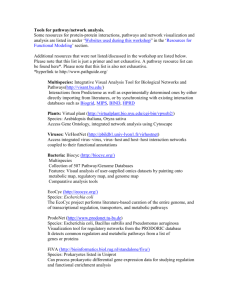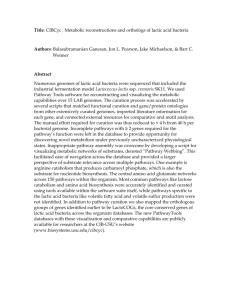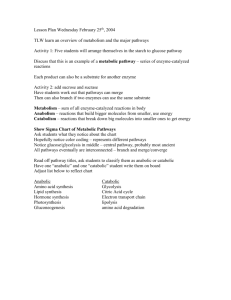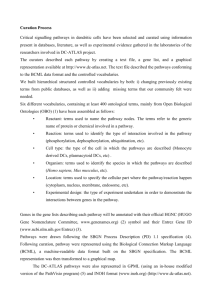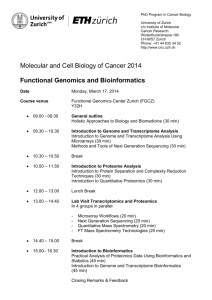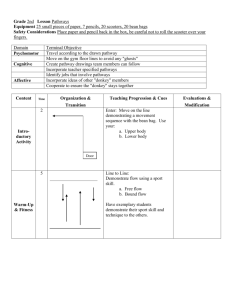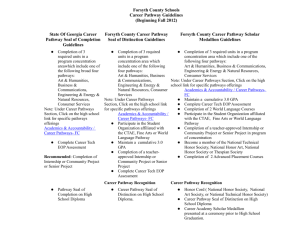A large amount of information that has direct bearing on pathwa
advertisement
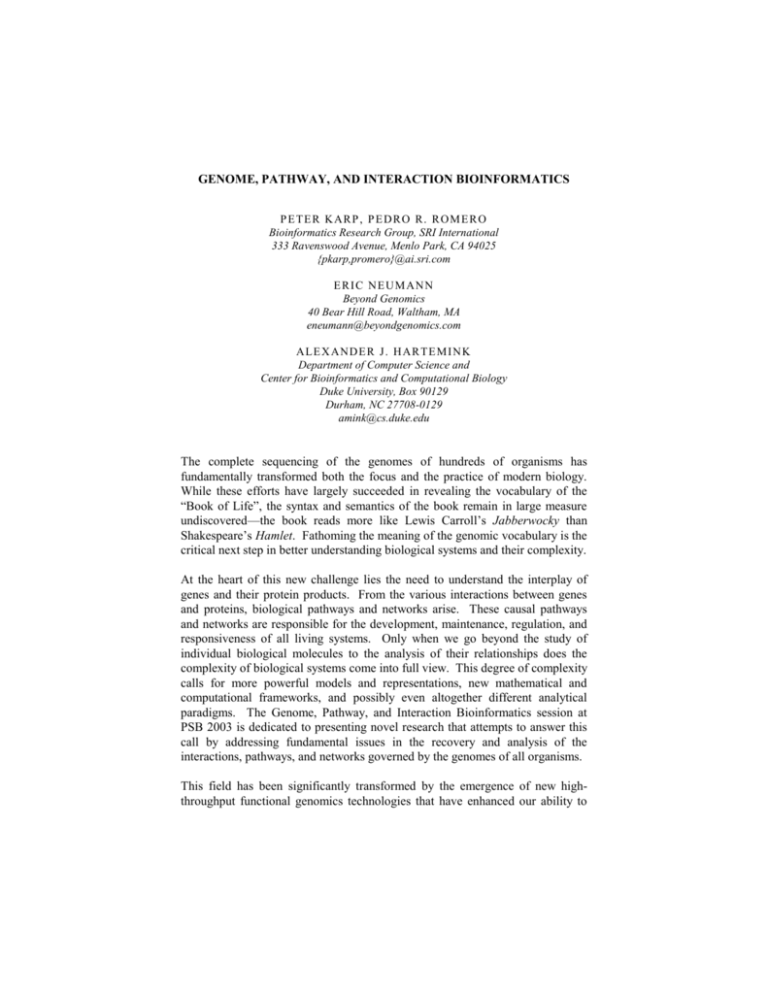
GENOME, PATHWAY, AND INTERACTION BIOINFORMATICS
P E TE R K AR P , P E D R O R . R O M E R O
Bioinformatics Research Group, SRI International
333 Ravenswood Avenue, Menlo Park, CA 94025
{pkarp,promero}@ai.sri.com
E R I C N E U M AN N
Beyond Genomics
40 Bear Hill Road, Waltham, MA
eneumann@beyondgenomics.com
ALE X AN D E R J . H AR TE M I N K
Department of Computer Science and
Center for Bioinformatics and Computational Biology
Duke University, Box 90129
Durham, NC 27708-0129
amink@cs.duke.edu
The complete sequencing of the genomes of hundreds of organisms has
fundamentally transformed both the focus and the practice of modern biology.
While these efforts have largely succeeded in revealing the vocabulary of the
“Book of Life”, the syntax and semantics of the book remain in large measure
undiscovered—the book reads more like Lewis Carroll’s Jabberwocky than
Shakespeare’s Hamlet. Fathoming the meaning of the genomic vocabulary is the
critical next step in better understanding biological systems and their complexity.
At the heart of this new challenge lies the need to understand the interplay of
genes and their protein products. From the various interactions between genes
and proteins, biological pathways and networks arise. These causal pathways
and networks are responsible for the development, maintenance, regulation, and
responsiveness of all living systems. Only when we go beyond the study of
individual biological molecules to the analysis of their relationships does the
complexity of biological systems come into full view. This degree of complexity
calls for more powerful models and representations, new mathematical and
computational frameworks, and possibly even altogether different analytical
paradigms. The Genome, Pathway, and Interaction Bioinformatics session at
PSB 2003 is dedicated to presenting novel research that attempts to answer this
call by addressing fundamental issues in the recovery and analysis of the
interactions, pathways, and networks governed by the genomes of all organisms.
This field has been significantly transformed by the emergence of new highthroughput functional genomics technologies that have enhanced our ability to
observe the functioning of complex biological systems. Experimental data
elucidating various aspects of bioloigical interactions, pathways, and networks is
being generated at an ever-increasing rate. This large ensemble of information
contains patterns that reflect pathway dynamics, and thus can be used to deduce
causal pathway structures. Progress in this field will depend at least partially on
the intelligent analysis and mining of this high-throughput functional genomics
data in order to infer pathways and their regulation.
Specific relevant types of high-throughput data include gene expression profiles
collected from high-density nucleotide arrays, protein expression profiles
collected from 2D gels and newer array-based assays, gene-protein interaction
data describing the binding location along the genome of DNA-binding proteins
collected using chromatin immunoprecipitation, protein-protein interaction data
collected using various hybrid systems, and the immense quantity of both gene
and protein sequence information accumulating in publicly available databases.
Each of these types of data presents a different perspective on the structure of
biological pathways and networks, and the most effective analytical methods will
likely draw their conclusions not from just a single type of data, but from the
combined evidence of data of many different types.
The papers in the session this year examine a number of different approaches to
the problem of network inference and modeling but retain some common themes.
The point of widest disagreement among the papers seems to be the appropriate
framework with which to model complex biological systems, the choices ranging
from S-systems and extensions thereof, to Bayesian and dynamic Bayesian
networks, to hybrid Petri nets, to full-blown systems of differential equations.
The theme of greatest commonality among the papers seems to be the need for
simulation to effectively evaluate the ability of these models to represent and
recover properties of complex biological systems.
Beyond the issues addressed in the papers of this session, a number of other
challenges in this field remain. Future work in the field will likely address such
thorny questions as: How do we compare and align individual pathways or
entire networks once uncovered? Can we infer qualitative network properties
when the immense number of quantitative parameters that govern their behavior
is not known? How can we effectively collect, organize, and integrate pathway
information? Are there new experimental techniques that can be developed to
reveal even more insights into the functioning of biological pathways? Finally,
we note that in addition to the functional aspects of networks of interaction,
spatial and temporal factors must also be taken into account when modeling
complex biological systems, the difficulty of which is only beginning to be
appreciated.
The field of genome, pathway, and interaction bioinformatics still includes many
challenges and holds much promise; a better understanding of the interaction
networks in complex biological systems will enable numerous advances in
biotechnology, not the least of which is an enhanced ability to target therapeutics
appropriately in diseased cells.

